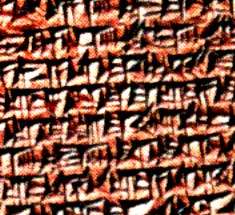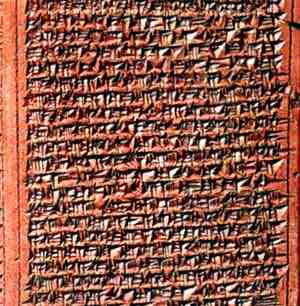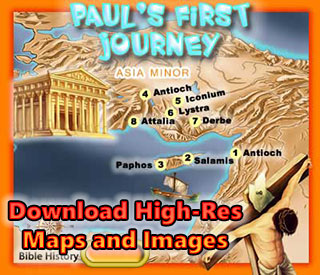Sennacherib, the great king, the mighty king, king of the world, king of Assyria, king of the four quarters, the wise shepherd, favorite of the great gods, guardian of right, lover of justice, who lends support, who comes to the aid of the destitute, who performs pious acts, perfect hero, mighty man, first among all princes, the powerful one who consumes the insubmissive, who strikes the wicked with the thunderbolt; the god Assur, the great mountain, an unrivaled kinship has entrusted to me, and above all those who dwell in palaces, has made powerful my weapons; from the upper sea of the setting sun to the lower sea of the rising sun, he has brought the black-headed people in submission at my feet; and mighty kings feared my warfare, leaving their homes and flying alone, like the sidinnu, the bird of the cave, to some inaccessible place...
In my third campaign, I went against the Hittite-land. Lul?, king of Sidon, the terrifying splendor of my sovereignty overcame him, and far off into the midst of the sea he fled. There he died. Great Sidon, Little Sidon, B?t-Zitti, Zaribtu, Mahalliba, Ushu, Akzib, Akko, his strong, walled cities, where there were fodder and drink, for his garrisons, the terrors of the weapon of Assur, my lord, overpowered them and they bowed in submission at my feet. I seated Tuba'lu on the royal throne over them, and tribute, gifts for my majesty, I imposed upon him for all time, without ceasing.
From Menachem, the Shamsimurunite, Tuba'lu the Sidonite, Abdi-liti the Arvadite, Uru-milki the Gublite, Mitinti the Ashdodite Budu-ilu the Beth Ammonite, Kammusu-nadbi the Moabite, Malik-rammu the Edomite, kings of Amurru, all of them, numerous presents as their heavy tribute, they brought before me for the fourth time, and kissed my feet.
But Sidka, the king of Ashkelon, who had not submitted to my yoke, the gods of his father's house, himself, his wife, his sons, his daughters, his brothers, the seed of his paternal house, I tore away and brought to Assyria. Sharru-lu-dari, son of Rukibti, their former king, I set over the people of Ashkelon, and I imposed upon him the payment of tribute: presents to my majesty. He accepted my yoke. In the course of my campaign, Beth-Dagon, Joppa, Banaibarka, Asuru, cities of Sidka, who had not speedily bowed in submission at my feet, I besieged, I conquered, I carried off their spoil.
The officials, nobles, and people of Ekron, who had thrown Padi their king?bound by oath and curse of Assyria? into fetters of iron and had given him over to Hezekiah, the Judahite?he kept him in confinement like an enemy? their heart became afraid, and they called upon the Egyptian kings, the bowmen, chariots and horses of the king of Meluhha [Ethiopia], a countless host, and these came to their aid. In the neighborhood of Eltekeh, their ranks being drawn up before me, they offered battle. With the aid of Assur, my lord, I fought with them and brought about their defeat. The Egyptian charioteers and princes, together with the Ethiopian king's charioteers, my hands captured alive in the midst of the battle. Eltekeh and Timnah I besieged, I captured, and I took away their spoil.
I approached Ekron and slew the governors and nobles who had rebelled, and hung their bodies on stakes around the city. The inhabitants who rebelled and treated (Assyria) lightly I counted as spoil. The rest of them, who were not guilty of rebellion and contempt, for whom there was no punishment, I declared their pardon. Padi, their king, I brought out to Jerusalem, set him on the royal throne over them, and imposed upon him my royal tribute.
As for Hezekiah the Judahite, who did not submit to my yoke: forty-six of his strong, walled cities, as well as the small towns in their area, which were without number, by levelling with battering-rams and by bringing up seige-engines, and by attacking and storming on foot, by mines, tunnels, and breeches, I besieged and took them. 200,150 people, great and small, male and female, horses, mules, asses, camels, cattle and sheep without number, I brought away from them and counted as spoil. (Hezekiah) himself, like a caged bird I shut up in Jerusalem, his royal city. I threw up earthworks against him? the one coming out of the city-gate, I turned back to his misery. His cities, which I had despoiled, I cut off from his land, and to Mitinti, king of Ashdod, Padi, king of Ekron, and Silli-b?l, king of Gaza, I gave (them). And thus I diminished his land. I added to the former tribute, and I laid upon him the surrender of their land and imposts?gifts for my majesty. As for Hezekiah, the terrifying splendor of my majesty overcame him, and the Arabs and his mercenary troops which he had brought in to strengthen Jerusalem, his royal city, deserted him. In addition to the thirty talents of gold and eight hundred talents of silver, gems, antimony, jewels, large carnelians, ivory-inlaid couches, ivory-inlaid chairs, elephant hides, elephant tusks, ebony, boxwood, all kinds of valuable treasures, as well as his daughters, his harem, his male and female musicians, which he had brought after me to Nineveh, my royal city. To pay tribute and to accept servitude, he dispatched his messengers..
Complete translations of the records of Sennacherib can be found in Daniel D. Luckenbill, Ancient Records of Assyria and Babylonia, vol. 2, and in James Pritchard's Ancient Near Eastern Texts (1950). |





